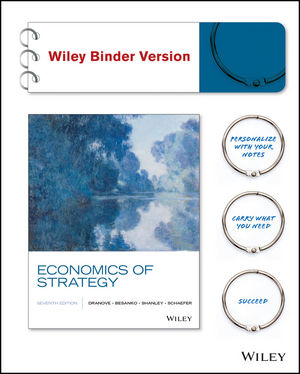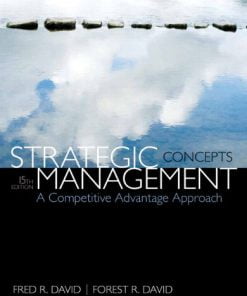Test bank for Economics of Strategy 7th Edition by Dranove
$55.00 Original price was: $55.00.$29.99Current price is: $29.99.
Test bank for Economics of Strategy 7th Edition by Dranove
Instant download Test bank for Economics of Strategy 7th Edition by Dranove pdf docx epub after payment.

Product details:
Table of contents:
Introduction: Strategy and Economics 1
Why Study Strategy? 1
Why Economics? 2
The Need for Principles 2
So What’s the Problem? 3
A Framework for Strategy 5
Boundaries of the Firm 6
Market and Competitive Analysis 6
Positioning and Dynamics 6
Internal Organization 6
The Book 7
Endnotes 7
Economics Primer: Basic Principles 8
Costs 9
Cost Functions 9
Total Cost Functions 9
Fixed and Variable Costs 11
Average and Marginal Cost Functions 11
The Importance of the Time Period: Long-Run versus Short-Run Cost Functions 14
Sunk versus Avoidable Costs 16
Economic Costs and Profitability 17
Economic versus Accounting Costs 17
Economic Profit versus Accounting Profit 18
Demand and Revenues 18
Demand Curve 18
The Price Elasticity of Demand 19
Brand-Level versus Industry-Level Elasticities 22
Total Revenue and Marginal Revenue Functions 22
Theory of the Firm: Pricing and Output Decisions 23
Perfect Competition 25
Game Theory 29
Games in Matrix Form and the Concept of Nash Equilibrium 30
Game Trees and Subgame Perfection 31
Chapter Summary 33
Questions 33
Endnotes 34
Part One Firm Boundaries 35
1 The Power of Principles: An Historical Perspective 37
Doing Business in 1840 37
Business Conditions in 1840: Life without a Modern Infrastructure 39
Transportation 39
Communications 40
Finance 41
Production Technology 42
Government 42
Doing Business in 1910 44
Business Conditions in 1910: A “Modern” Infrastructure 45
Production Technology 45
Transportation 45
Communications 46
Finance 46
Government 46
Doing Business Today 48
Modern Infrastructure 49
Transportation 49
Communications 49
Finance 50
Production Technology 50
Government 50
Infrastructure in Emerging Markets 51
Three Different Worlds: Consistent Principles, Changing Conditions, and Adaptive Strategies 52
Chapter Summary 52
Questions 53
Endnotes 54
2 The Horizontal Boundaries of The Firm 55
Definitions 55
Definition of Economies of Scale 55
Definition of Economies of Scope 57
Scale Economies, Indivisibilities, and the Spreading of Fixed Costs 57
Economies of Scale Due to Spreading of Product-Specific Fixed Costs 58
Economies of Scale Due to Trade-offs among Alternative Technologies 58
Indivisibilities Are More Likely When Production is Capital Intensive 60
“The Division of Labor is Limited by the Extent of the Market” 62
Special Sources of Economies of Scale and Scope 64
Density 64
Purchasing 65
Advertising 65
Costs of Sending Messages per Potential Consumer 65
Advertising Reach and Umbrella Branding 66
Research and Development 66
Physical Properties of Production 67
Inventories 67
Complementarities and Strategic Fit 68
Sources of Diseconomies of Scale 68
Labor Costs and Firm Size 69
Spreading Specialized Resources Too Thin 69
Bureaucracy 69
Economies of Scale: A Summary 70
The Learning Curve 70
The Concept of the Learning Curve 70
Expanding Output to Obtain a Cost Advantage 71
Learning and Organization 73
The Learning Curve versus Economies of Scale 74
Diversification 75
Why Do Firms Diversify? 76
Efficiency-Based Reasons for Diversification 76
Scope Economies 76
Internal Capital Markets 77
Problematic Justifications for Diversification 78
Diversifying Shareholders’ Portfolios 78
Identifying Undervalued Firms 78
Reasons Not to Diversify 79
Managerial Reasons for Diversification 79
Benefits to Managers from Acquisitions 79
Problems of Corporate Governance 80
The Market for Corporate Control and Recent Changes in Corporate Governance 81
Performance of Diversified Firms 83
Chapter Summary 85
Questions 86
Endnotes 88
3 The Vertical Boundaries of The Firm 90
Make versus Buy 90
Upstream, Downstream 92
Defining Boundaries 94
Some Make-or-Buy Fallacies 94
Avoiding Peak Prices 95
Tying Up Channels: Vertical Foreclosure 96
Reasons to “Buy” 98
Exploiting Scale and Learning Economies 98
Bureaucracy Effects: Avoiding Agency and Influence Costs 101
Agency Costs 101
Influence Costs 102
Organizational Design 104
Reasons to “Make” 104
The Economic Foundations of Contracts 104
Complete versus Incomplete Contracting 105
Bounded Rationality 105
Difficulties Specifying or Measuring Performance 106
Asymmetric Information 106
The Role of Contract Law 106
Coordination of Production Flows through the Vertical Chain 107
Leakage of Private Information 109
Transaction Costs 110
Relationship-Specific Assets 111
Forms of Asset Specificity 111
The Fundamental Transformation 112
Rents and Quasi-Rents 112
The Holdup Problem 113
Holdup and Ex Post Cooperation 115
The Holdup Problem and Transaction Costs 115
Contract Negotiation and Renegotiation 115
Investments to Improve Ex Post Bargaining Positions 116
Distrust 116
Reduced Investment 117
Recap: From Relationship-Specific Assets to Transaction Costs 117
Summarizing Make-or-Buy Decisions: The Make-or-Buy Decision Tree 118
Chapter Summary 119
Questions 119
Endnotes 122
4 Integration and Its Alternatives 124
What Does It Mean to Be “Integrated”? 124
The Property Rights Theory of the Firm 124
Alternative Forms of Organizing Transactions 125
Governance 127
Delegation 128
Recapping PRT 128
Path Dependence 129
Making the Integration Decision 129
Technical Efficiency versus Agency Efficiency 130
The Technical Efficiency/Agency Efficiency Trade-off 130
Real-World Evidence 134
Double Marginalization: A Final Integration Consideration 136
Alternatives to Vertical Integration 138
Tapered Integration: Make and Buy 138
Franchising 138
Strategic Alliances and Joint Ventures 140
Implicit Contracts and Long-Term Relationships 143
Business Groups 145
Keiretsu 145
Chaebol 147
Business Groups in Emerging Markets 148
Chapter Summary 149
Questions 150
Endnotes 151
Part Two Market and Competitive Analysis 153
5 Competitors and Competition 155
Competitor Identification and Market Definition 156
The Basics of Market Definition and Competitor Identification 156
Putting Competitor Identification into Practice 157
Empirical Approaches to Competitor Identification 158
Geographic Competitor Identification 160
Measuring Market Structure 162
Market Structure and Competition 163
Perfect Competition 163
Many Sellers 164
Homogeneous Products 164
Excess Capacity 165
Monopoly 166
Monopolistic Competition 168
Demand for Differentiated Goods 168
Entry into Monopolistically Competitive Markets 169
Oligopoly 170
Cournot Quantity Competition 171
The Revenue Destruction Effect 174
Cournot’s Model in Practice 175
Bertrand Price Competition 175
Why Are Cournot and Bertrand Different? 177
Bertrand Price Competition When Products Are Horizontally Differentiated 179
Evidence on Market Structure and Performance 181
Price and Concentration 181
Chapter Summary 182
Questions 182
Endnotes 184
6 Entry and Exit 186
Some Facts about Entry and Exit 187
Entry and Exit Decisions: Basic Concepts 188
Barriers to Entry 188
Bain’s Typology of Entry Conditions 189
Analyzing Entry Conditions: The Asymmetry Requirement 189
Structural Entry Barriers 191
Control of Essential Resources 191
Economies of Scale and Scope 192
Marketing Advantages of Incumbency 194
Barriers to Exit 195
Entry-Deterring Strategies 196
Limit Pricing 196
Is Strategic Limit Pricing Rational? 198
Predatory Pricing 200
The Chain-Store Paradox 200
Rescuing Limit Pricing and Predation: The Importance of Uncertainty and Reputation 202
Wars of Attrition 203
Predation and Capacity Expansion 204
Strategic Bundling 205
“Judo Economics” 206
Evidence on Entry-Deterring Behavior 207
Contestable Markets 208
An Entry Deterrence Checklist 208
Entering a New Market 208
Preemptive Entry and Rent-Seeking Behavior 210
Chapter Summary 211
Questions 212
Endnotes 213
7 Dynamics: Competing Across Time 214
Microdynamics 215
The Strategic Benefits of Commitment 215
Strategic Substitutes and Strategic Complements 216
The Strategic Effect of Commitments 217
Tough and Soft Commitments 219
A Taxonomy of Commitment Strategies 219
The Informational Benefits of Flexibility 220
Real Options 222
A Framework for Analyzing Commitments 223
Competitive Discipline 224
Dynamic Pricing Rivalry and Tit-for-Tat Pricing 225
Why is Tit-for-Tat So Compelling? 227
Coordinating on the Right Price 227
Impediments to Coordination 229
The Misread Problem 229
Lumpiness of Orders 230
Information about the Sales Transaction 231
Volatility of Demand Conditions 231
Asymmetries among Firms and the Sustainability of Cooperative Prices 232
Price Sensitivity of Buyers and the Sustainability of Cooperative Pricing 233
Market Structure and the Sustainability of Cooperative Pricing: Summary 233
Facilitating Practices 234
Price Leadership 234
Advance Announcement of Price Changes 234
Most Favored Customer Clauses 234
Uniform Delivered Prices 236
Where Does Market Structure Come From? 237
Sutton’s Endogenous Sunk Costs 238
Innovation and Market Evolution 240
Learning and Industry Dynamics 241
Chapter Summary 241
Questions 242
Endnotes 244
8 Industry Analysis 247
Performing a Five-Forces Analysis 248
Internal Rivalry 249
Entry 250
Substitutes and Complements 251
Supplier Power and Buyer Power 251
Strategies for Coping with the Five Forces 252
Coopetition and the Value Net 253
Applying the Five Forces: Some Industry Analyses 255
Chicago Hospital Markets Then and Now 255
Market Definition 255
Internal Rivalry 255
Entry 256
Substitutes and Complements 257
Supplier Power 257
Buyer Power 258
Commercial Airframe Manufacturing 259
Market Definition 259
Internal Rivalry 259
Barriers to Entry 260
Substitutes and Complements 261
Supplier Power 261
Buyer Power 262
Professional Sports 262
Market Definition 262
Internal Rivalry 262
Entry 264
Substitutes and Complements 266
Supplier Power 267
Buyer Power 267
Conclusion 267
Professional Search Firms 268
Market Definition 268
Internal Rivalry 268
Entry 269
Substitutes and Complements 269
Supplier Power 270
Buyer Power 270
Conclusion 270
Chapter Summary 271
Questions 271
Endnotes 275
Part Three Strategic Position and Dynamics 277
9 Strategic Positioning For Competitive Advantage 279
Competitive Advantage and Value Creation: Conceptual Foundations 280
Competitive Advantage Defined 280
Maximum Willingness-to-Pay and Consumer Surplus 281
From Maximum Willingness-to-Pay to Consumer Surplus 282
Value-Created 284
Value Creation and “Win–Win” Business Opportunities 287
Value Creation and Competitive Advantage 288
Analyzing Value Creation 288
Value Creation and the Value Chain 292
Value Creation, Resources, and Capabilities 292
Strategic Positioning: Cost Advantage and Benefit Advantage 296
Generic Strategies 296
The Strategic Logic of Cost Leadership 296
The Strategic Logic of Benefit Leadership 298
Extracting Profits from Cost and Benefit Advantage 301
Comparing Cost and Benefit Advantages 302
“Stuck in the Middle” 304
Diagnosing Cost and Benefit Drivers 306
Cost Drivers 306
Cost Drivers Related to Firm Size, Scope, and Cumulative Experience 307
Cost Drivers Independent of Firm Size, Scope, or Cumulative Experience 307
Cost Drivers Related to Organization of the Transactions 308
Benefit Drivers 308
Methods for Estimating and Characterizing Costs and Perceived Benefits 309
Estimating Costs 309
Estimating Benefits 310
Strategic Positioning: Broad Coverage versus Focus Strategies 310
Segmenting an Industry 310
Broad Coverage Strategies 311
Focus Strategies 312
Chapter Summary 314
Questions 315
Endnotes 318
10 Information and Value Creation 320
The “Shopping Problem” 321
Unraveling 322
Alternatives to Disclosure 323
Nonprofit Firms 327
Report Cards 327
Multitasking: Teaching to the Test 328
What to Measure 331
Risk Adjustment 335
Presenting Report Card Results 336
Gaming Report Cards 337
The Certifier Market 339
Certification Bias 340
Matchmaking 342
When Sellers Search for Buyers 343
Chapter Summary 345
Questions 346
Endnotes 347
11 Sustaining Competitive Advantage 349
Market Structure and Threats to Sustainability 349
Threats to Sustainability in Competitive and Monopolistically Competitive Markets 350
Threats to Sustainability under All Market Structures 351
Evidence: The Persistence of Profitability 351
The Resource-Based Theory of the Firm 353
Imperfect Mobility and Cospecialization 353
Isolating Mechanisms 355
Impediments to Imitation 358
Legal Restrictions 358
Superior Access to Inputs or Customers 359
The Winner’s Curse 361
Market Size and Scale Economies 361
Intangible Barriers to Imitation 362
Causal Ambiguity 363
Dependence on Historical Circumstances 363
Social Complexity 363
Early-Mover Advantages 364
Learning Curve 364
Reputation and Buyer Uncertainty 364
Buyer Switching Costs 364
Network Effects 365
Networks and Standards 365
Competing “For the Market” versus “In the Market” 366
Knocking Off a Dominant Standard 367
Early-Mover Disadvantages 367
Imperfect Imitability and Industry Equilibrium 368
Creating Advantage and Creative Destruction 370
Disruptive Technologies 370
The Productivity Effect 371
The Sunk Cost Effect 371
The Replacement Effect 372
The Efficiency Effect 372
Disruption versus the Resource-Based Theory of the Firm 373
Innovation and the Market for Ideas 373
Evolutionary Economics and Dynamic Capabilities 375
The Environment 376
Factor Conditions 376
Demand Conditions 376
Related Supplier or Support Industries 376
Strategy, Structure, and Rivalry 378
Chapter Summary 378
Questions 379
Endnotes 381
Part Four Internal Organization 383
12 Performance Measurement and Incentives 385
The Principal–Agent Relationship 386
Combating Agency Problems 386
Performance-Based Incentives 388
Problems with Performance-Based Incentives 393
Preferences over Risky Outcomes 393
Risk Sharing 394
Risk and Incentives 396
Performance Measures That Fail to Reflect All Desired Actions 399
Selecting Performance Measures: Managing Trade-offs between Costs 401
Do Pay-for-Performance Incentives Work? 404
Implicit Incentive Contracts 405
Subjective Performance Evaluation 405
Promotion Tournaments 406
Efficiency Wages and the Threat of Termination 409
Incentives in Teams 410
Chapter Summary 413
Questions 414
Endnotes 416
People also search:
Economics of Strategy 7th Edition
Economics of Strategy 7th Edition pdf
Economics of Strategy
economic and investment strategy advisor
|
economics of competition and strategy
|
what is economic strategies
Related products
Test Bank
Test Bank for Operating Systems: Internals and Design Principles, 7th Edition: William Stallings











